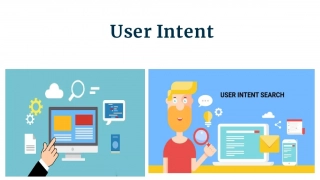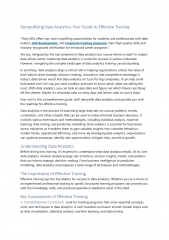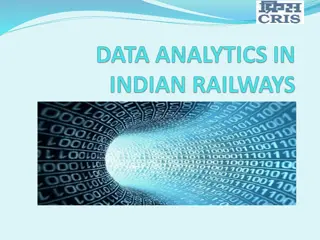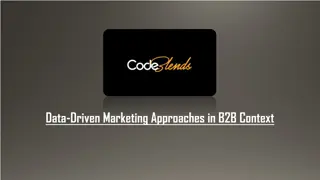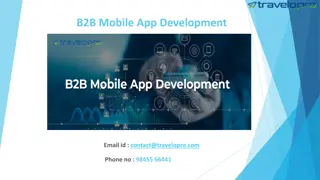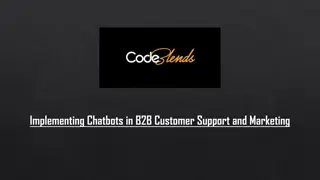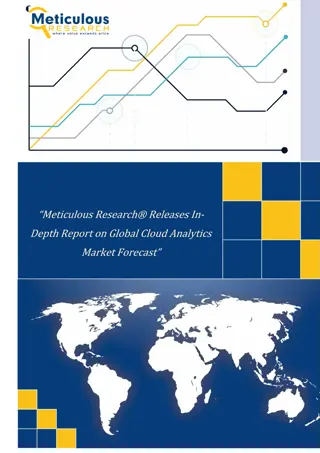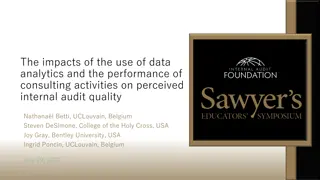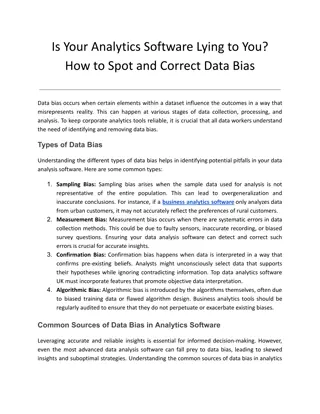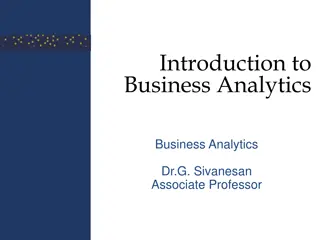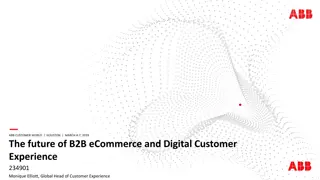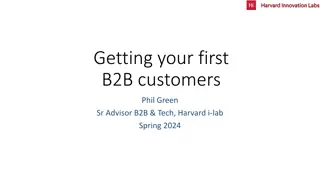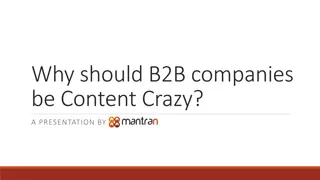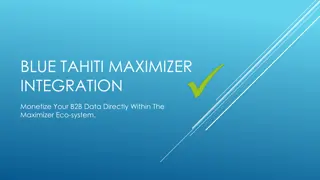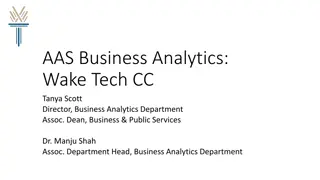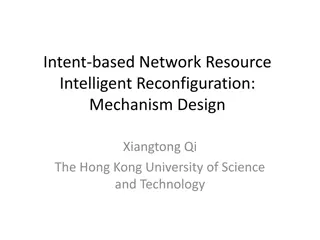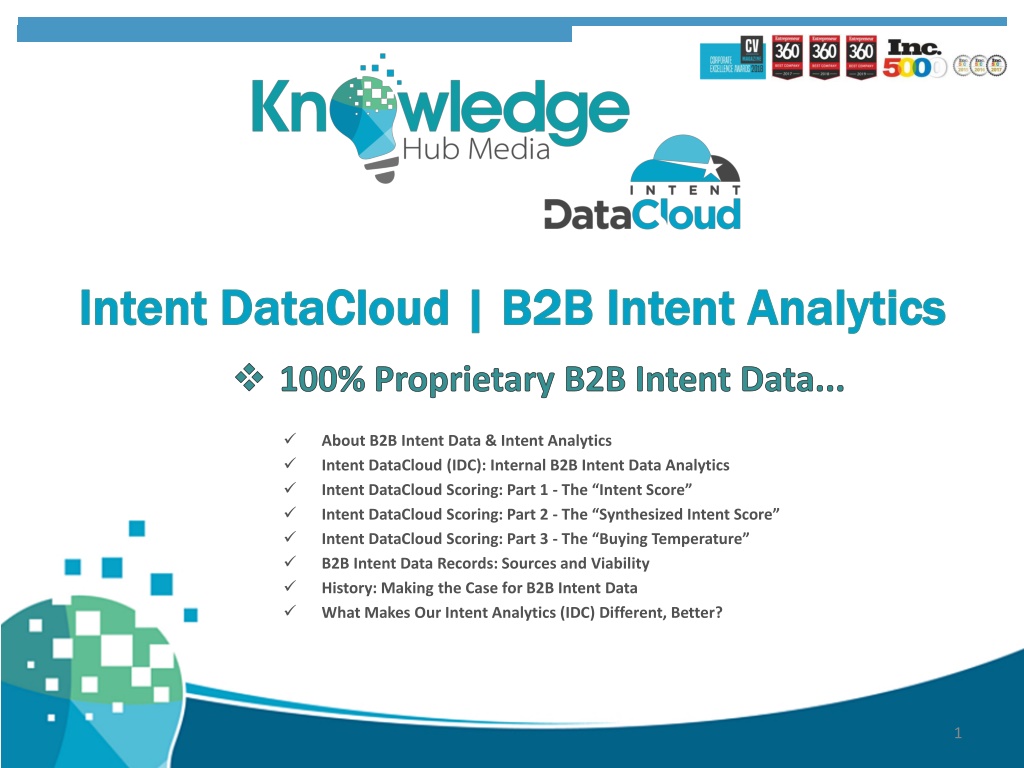
Empowering B2B Businesses with Intent Data Analytics
Uncover the power of B2B intent data analytics through Knowledge Hub Media's IDC platform. Discover how internal data sources drive intelligent insights to predict future customers' buying behavior before they are even aware. Leverage intent analytics to build targeted account lists, prioritize accounts showing high intent, and predict impending purchases accurately. Gain a competitive edge in understanding active demand for specific products and services within B2B organizations.
Download Presentation

Please find below an Image/Link to download the presentation.
The content on the website is provided AS IS for your information and personal use only. It may not be sold, licensed, or shared on other websites without obtaining consent from the author. If you encounter any issues during the download, it is possible that the publisher has removed the file from their server.
You are allowed to download the files provided on this website for personal or commercial use, subject to the condition that they are used lawfully. All files are the property of their respective owners.
The content on the website is provided AS IS for your information and personal use only. It may not be sold, licensed, or shared on other websites without obtaining consent from the author.
E N D
Presentation Transcript
Intent Intent DataCloud DataCloud | B2B Intent Analytics | B2B Intent Analytics 100% Proprietary B2B Intent Data... About B2B Intent Data & Intent Analytics Intent DataCloud (IDC): Internal B2B Intent Data Analytics Intent DataCloud Scoring: Part 1 - The Intent Score Intent DataCloud Scoring: Part 2 - The Synthesized Intent Score Intent DataCloud Scoring: Part 3 - The Buying Temperature B2B Intent Data Records: Sources and Viability History: Making the Case for B2B Intent Data What Makes Our Intent Analytics (IDC) Different, Better? 1
Knowledge Hub Media Intent DataCloud The only B2B intent data analytics that your company will ever need. - Knowledge Hub Media s Intent DataCloud (IDC) Platform offers intelligent B2B buyer intent data. Our intent data analytics are derived internally from Content Syndication, Demand Generation, Website Analytics, Email Marketing Metrics and Social Listening, among other channels. - The prospect of utilizing B2B Intent Data grows in popularity almost daily, and Knowledge Hub Media s IDC platform analyzes the content consumption of B2B companies and their employees in an effort to determine when there is active demand for specific types of products, business services and technology solutions. In other words, out intent analytics give us insight into which companies are likely in the buying cycle for specific types of products / solutions. - Our IDC intent data analytics are based on organizational content consumption, such as white paper downloads, asset and webinar registrations, website and landing page analytics, dedicated email marketing promotions, and social listening. In a nutshell, the intent data records houses within our platform can predict your future customers before they are even aware that they're actively looking to buy. 2
Knowledge Hub Media Intent DataCloud Intent DataCloud - A 100% proprietary B2B intent analytics solution. - IDC s back-end data analytics use multiple sources to identify organizations that are actively researching specific products and solutions, with an implied intent to purchase said products and solutions in the near future. Currently, the platform encompasses over 770+ unique and targeted Intent Topics. - Based on white paper downloads, asset registrations, social interactions, and overall B2B content consumption, Intent DataCloud generates intelligent intent analytics that can be leveraged to easily: Build Target Accounts Lists (ABM Lists) made up of companies that are already interested in your company s products, services and technology solutions. Overlay current targeting criteria such as industry selects, company sizes targeted, and ideal annual revenue ranges on top of companies that are associated with the appropriate intent topics for their lines of products and services. Identify companies that range anywhere on the buying spectrum from "actively researching" specific services and solutions, to those who have allocated budgets already in place, to the bottom of the funnel companies, that are ready to pull the trigger and decide on a vendor Depending on the current intent data and 3-tiered intent scoring, the impending purchase can be predicted to occur within the next 12 months, 6 months, 3 months, or even 30 days. - Speaking of scoring, Intent DataCloud s 960,000+ intent data company records are scored in three separate ways - allowing users to gauge and prioritize accounts that are showing higher levels of intent than others 3
Knowledge Hub Media Intent DataCloud Intent DataCloud Scoring Mechanism #1 | The Intent Score Intent Score: An indication of the level of interest an organization has in any given intent topic(s), based on content consumption types, frequencies, and cross-organizational volume. o First our standard Intent Score can be used to gauge the overall potential for conversion on a single intent topic, and, to allow for the prioritization of accounts based on level of intent for said topic. Intent Scores are generated and provided for each company (account) using a numeric value of either a 5, 6, 7, 8 or 9. These score are all dependent on that company s content consumption habits. Example 1-A: An Intent Score of 5 is the lowest mark that a company record can receive, showing buyer intent, but at a somewhat minimal level based on our overall scoring criteria. Example 1-B: An Intent Score of 9 is the highest mark that a company can receive, and generally speaking, is a valid predictor of organizations that have the most apparent need for a specific product, service or solution. Example 1-C: An Intent Score of 9 also conveys the highest potential for an organization to make purchasing decisions in the short run for their intent topic(s) of interest. In addition to our baseline Intent Score metric, Intent DataCloud adds two additional layers of insight for companies that are showing buyer intent... o o o o o 4
Knowledge Hub Media Intent DataCloud Intent DataCloud Scoring Mechanism #2 | The Synthesized Intent Score Synthesized Intent Score: A combined or converged type of intent score, calculated by the amount and frequency of related content being consumed by an organization. o Example 2-A:If a company is researching Data Governance solutions but also consuming content about other, closely related data management topics such as Data Integrity and Data Security" it can potentially have a positive impact on that company s Synthesized Intent Score. The Synthesized Intent Score can be though of as a combined or converged intent score. Just like our regular Intent Score, Synthesized Intent Scores are assigned a numeric value of either a 5, 6, 7, 8 or 9 Again, graded based on organizational content consumption throughout a company (i.e. account ). Consuming content from related topics can help to increase a company s Synthesized Intent Score often, to where it becomes even more important and valuable to than our standard Intent Score. Example 2-B: In looking at the Data Governanceexample from above... While a company s Intent Score for a topic such as Data Governance, Data Integrity or Data Security might only be a 7 individually, their Synthesized Intent Score (i.e. combined score of all three related topics) will often equate to a much more significant grade of 8 or 9. It is all dependent on the level of organizational content consumption. A company s Synthesized Intent Score for any topic is also dependent on types of content consumed, the frequencies, the channels utilized, and the company s cross-organizational consumption volume. o o o o 5
Knowledge Hub Media Intent DataCloud Intent DataCloud Scoring Mechanism #3 | The Buying Temperature Buying Temperature: Is scored on a four level, tiered scale From Level 1 (the highest level of purchase intent) to Level 4 (a more minimal level of intent). o Statistically significant Buying Temperature scores are available when companies and their associated employees actively express that they have either (1) a current budget in place, and/or (2) a favorable timeframe in place for making a purchasing decision related to the solution represented by the specific intent topic(s) that they are researching. Companies and their employees influence their organizational Buying Temperature levels based on their responses to BANT, SQL, and SRL custom questions which are aimed to extract more information about how quickly a company is looking to make a purchase decision and/or whether they already have a budget authorized / in place for any given Intent Topic(s). Example 3-A: Companies with no budget or foreseeable purchase timeframe (i.e. greater than 12 months into the future), or, who have simply provided no data on their buying timeframe and/or approved budget are automatically scored at Level 4. While still relevant, Level 4 is the lowest Buying Temperature grade that a company can receive. Companies that do have budgets planned and in place or that have a buying timeframe in the ranges of < 30 days, 1-3 months, 3-6 months, or 6-12 months are assigned Buying Temperature scores that correspond with their standard Intent Scores, and the increased probability of making a purchase decision based on their current approved and/or planned budgets and timelines. Example 3-B: The highest Buying Temperature score is Level 1. A Level 1 grade is often representative of companies with an Intent Score of 8 or 9, that have also indicated a readiness to make a purchase decision within the next 30 days and/or have a budget approved and ready to go for the specific intent topics (products, solutions) that they have been researching. o o o o 6
Knowledge Hub Media Intent DataCloud B2B Intent Data: The inputs, the sources, and the driving analytics. - To sum it all up, our intuitive intent data analytics measure the consumption of B2B content across multiple channels... Organizational content consumption via content syndication, white paper and webinar registrations, website and landing page analytics, and social listening are just some of the channels that we utilize. The resulting product is a targeted compilation of highly viable buyer intent data records, which are used to create targeted ABM lists. ABM lists made up of companies that are currently researching and in the market for various B2B products, business services and technology solutions. Knowledge Hub Media generates tens of thousands of unique (highly targeted) B2B leads through internal content syndication and demand generation on a monthly basis. As such, our Intent DataCloud analytics are updated regularly. The intent data records that we provide to our customers are never stale or outdated lists, and we are always evolving to make things even more efficient from data quality standpoint. The main takeaway is that our intent data is dynamic and always changing. To put it into consumer thinking When somebody is in the market to buy a new car, how long do they remain in that market? Maybe a week, maybe a month, maybe a year? It s all dependent on whether or not they even buy a new car Then when they buy the new car And then consequently, when they stop researching new cars. - - - - 7
Knowledge Hub Media Intent DataCloud How history helps make the case for intent data analytics. - Intent Data has been going strong for a couple of years, now, and we have already heard some real success stories via beta testers, case studies, testimonials, lead scoring metrics, conversion rates, and overall ROI calculations. - Based on recent third-party intent analytics case studies and internal organizational KPI's, here are a few of the notable success stories from some of the more well-known B2B brands in the industry: Fortinet was able to significantly increase their efficiencies in terms of account prioritization with the use of intent data, which in turn, helped them drive their sales pipeline and increase revenue growth. Salesforce experienced a return-on-investment of 271% for digital display and paid social ads thanks to intent data targeting. The use of intent data also cut Salesforce s typical sales cycle time down by 33%. Veristor experienced a two-fold increase in email open rates, an 18% increase in event attendance with intent data. Oceanos increased their email marketing engagements by more than 25% with targeted intent data. Marketo integrated intent data directly into their marketing automation platform, which greatly assisted sales and marketing by helping them identify the right accounts to engage with. DataStax utilized intent data to prioritize accounts for social media and account-based marketing programs. The results yielded a 40% increase in paid social engagement, and a 60% increase in Terminus display advertising. Turbonomic was able to increase their email conversion rates by 36% with the implementation of intent data. OneLogin doubled their marketing campaign engagement and shortened their sales cycles via the use of intent data. MarketMatrix used intent to I.D. current customers, target accounts, and repeat incidences of demonstrated intent. 8
Knowledge Hub Media Intent DataCloud What makes Intent DataCloud different And frankly, so much better? - The Intent DataCloud platform and our backend analytics allow for full geographic targeting (company profiles by country) and install base intelligence targeting in certain, viable situations. - Our solution enables easier identification of companies that already have budget and/or have a planned purchase timeframe in mind for one or more products, services or solutions (intent topics). - We use a hybrid approach, collecting buyer intent data via content syndication (internal and third party), internal lead generation campaigns, web and landing page analytics, email marketing, page tracking intelligence, social listening strategies, and B2B market research surveys. - Implied Intent and Intent Scoring mechanisms are based on the frequency that an account is matched with specific and/or related intent data topics. Intent DataCloud aggregates scoring across several criteria: Consumption frequencies via individual campaigns. Consumption frequencies across multiple and similar content types. The variance in data sources utilized to measure and predict buyer intent. The aggregate sources of information accessed with associated points of data origination. The total number of different/varying channels used to record content consumption and intent probability. 9



